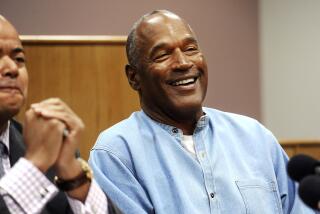THE O.J. SIMPSON MURDER TRIAL
- Share via
UCLA law professor Peter Arenella and Loyola Law School professor Laurie Levenson offer their take on the Simpson trial. Joining them is defense attorney Jill Lansing, who will rotate with other experts as the case moves forward. Today’s topic: Dirty Socks and DNA.
PETER ARENELLA
On the prosecution: “The prosecution should be grateful that Judge Ito’s bark is worse than his bite. Rockne Harmon’s contacting defense experts was ‘reprehensible,’ but Ito didn’t sanction him because Harmon didn’t learn any defense secrets. Prosecutorial defiance of a discovery order that might have damaged Barry Scheck’s credibility with the jury led Ito to propose a curative jury instruction that the defense surely will see as too little, too late.”
On the defense: “Can too much DNA be a bad thing? The defense wants the jury to believe that the Bundy rear gate has much more un-degraded O.J. DNA than any other evidence sample because the blood was taken from his unsealed reference vial and planted there. Can success breed failure? Ironically, the defense’s success in attacking the coroner’s competence helped justify Ito’s decision to admit gruesome autopsy photos to compensate for those deficiencies.”
LAURIE LEVENSON
On the prosecution: “Your mother’s worst nightmare. People looking at your dirty socks under a microscope. Harmon wants the jurors to see how small the blood specks are because it is unlikely that police would have gone to all the trouble to plant microscopic amounts. Such small amounts might also explain why examiners initially missed the stains and why Simpson left the socks behind. Small as they were, the jurors got an eye full.”
On the defense: “As bad as bloody socks may look, they’re nothing compared to photos of a slit throat. The defense now knows that jurors will see such pictures. When they do, they probably will find them more relevant than Scheck’s questions regarding vaginal smears. Meanwhile, ‘five more minutes, Mr. Scheck’ has become as reliable an estimate as ‘the trial will be over in June.’ You have to wonder whether the jury’s energy matches Scheck’s.”
JILL LANSING
On the prosecution: “The prosecution astutely used a microscopic viewing of the bloody socks to involve the jurors in the testimony. But the speed with which the jurors accomplished this task may reflect that they’ve heard all they need to regarding DNA. The question is whether they’re convinced or beyond convincing. Ito’s ruling admitting the majority of the bloody photos helps prosecutors, but can’t really have surprised the defense.”
On the defense: “Scheck reminded the jury once again that the prosecution’s witnesses can’t tell them how or when blood was deposited on any surface. The apparent contradiction between the degraded blood stains seized at the time of the crime and the DNA-loaded back gate sample will continue to haunt the prosecution. Scheck’s questioning of Gary Sims within arm’s reach of the jurors refocused their attention in a well-worn area.”
Compiled by TIM RUTTEN / Los Angeles Times
More to Read
Sign up for Essential California
The most important California stories and recommendations in your inbox every morning.
You may occasionally receive promotional content from the Los Angeles Times.










